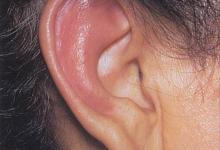Is PMR the Next Indication for Tocilizumab? Save

About half of patients with steroid-dependent polymyalgia rheumatica (PMR) were able to get off steroids altogether when they were started on tocilizumab (Actemra) infusions, which also improved disease control in most cases, a randomized phase III trial showed.
In a 24-week study, 49.0% of patients assigned to the interleukin (IL)-6 inhibitor were no longer taking prednisone at their final evaluation, compared with 19.6% of a placebo group, according to Valérie Devauchelle-Pensec, MD, PhD, of Hôpital de la Cavale Blanche in Brest, France, and colleagues.
The tocilizumab group also showed substantially greater declines in PMR Activity Score (PMR-AS) values relative to the placebo group when either C-reactive protein (CRP) levels or erythrocyte sedimentation rate (ESR) was taken into account, they reported in JAMA.
Adverse effects were in line with those seen in other tocilizumab studies, with increased rates of infections most prominent.
While these results suggest that PMR could become a seventh approved indication for tocilizumab, Devauchelle-Pensec and colleagues offered a series of cautions. Among them: with just 100 patients evaluable for safety, the trial was not powered to find differences from placebo. Also, the primary endpoint (a composite of CRP and PMR-AS plus steroid dose reduction) hasn't been fully validated, and for reasons that remain uncertain, there was no advantage for tocilizumab in patient-reported measures of quality of life.
"Further research is needed to confirm efficacy and to determine the balance of potential benefits and harms," the investigators wrote -- a point echoed in an accompanying editorial.
Brendan Antiochos, MD, of Johns Hopkins University in Baltimore, noted that patients included in the study were a highly selected group, marked by long disease duration and relatively large daily prednisone doses. "Therefore, these results do not apply to all patients with PMR, some of whom can be treated with much lower doses of prednisone or tapered off steroids entirely over a similar timeframe," he argued.
Antiochos also pointed to the infection risk with tocilizumab as well as its high cost. "[A] treatment strategy for patients with refractory disease, or for patients with comorbidities that make even modest doses of prednisone over a long timeframe highly undesirable, should be the focus of future studies of novel approaches to managing PMR," he wrote.
Nevertheless, he added, the findings do indicate that tocilizumab represents "a possible new approach" in PMR therapy, which future studies should clarify.
The SEMAPHORE trial was conceived to test whether a direct attack on IL-6 would be helpful in PMR, following encouraging results in three smaller open-label trials. One of these, involving 20 patients with newly diagnosed PMR and no history of steroid use, found that tocilizumab helped all of them achieve PMR-AS scores of 10 or less at 12 weeks, indicating low disease activity.
To be eligible for the phase III study, patients had to be at least 50 years old and to have had CRP levels of at least 10 mg/L or ESR of at least 20 mm/hour at disease onset. They also had to have been responsive to 12-25 mg/day of prednisone (with response defined as reduction in CRP or ESR values to below the thresholds of 10 mg/L and 20 mm/hour, respectively), while also showing increased disease activity (CRP PMR-AS values above 10; the scale runs 0-100) when steroid tapering was attempted. A host of comorbidities served as exclusion criteria, as did prednisone dosing greater than 25 mg/day.
SEMAPHORE randomized 101 patients to tocilizumab or placebo. One assigned to the former never received the drug and was excluded from the primary analysis. Patients who were on stable doses of methotrexate or hydroxychloroquine at enrollment were allowed to continue them. Tocilizumab was scheduled for infusions of 8 mg/kg every 4 weeks, for a total of six doses. Attempts to taper steroid doses commenced at week 8.
The primary endpoint was achievement of CRP PMR-AS of 10 or less plus successful tapering of steroid doses either to 5 mg/day or less or by at least 10 mg/day from patients' baseline dosage. The PMR-AS scale is calculated from minutes of morning stiffness, ability to elevate the arms, physician's global assessment, and patient-reported pain.
This outcome was achieved by 67.3% of the tocilizumab group versus 31.4% of those assigned to placebo; after adjustment for differences in baseline parameters, the difference was 36.0 percentage points (95% CI 19.4-52.6).
Additionally, seven of 11 prespecified secondary outcomes also favored tocilizumab significantly. These included CRP and ESR PMR-AS values independent of steroid dosing, final mean steroid doses (6.1 mg/day with placebo vs 3.8 mg/day with tocilizumab), and rates of steroid freedom.
Scores on the Short Form-36's mental and physical health components and on the Health Assessment Questionnaire's disability index, however, differed little between groups at week 24. Devauchelle-Pensec and colleagues suggested this "discrepancy" with more objective efficacy measures may mean that steroid-dependent PMR patients "may not be aware of improvement from tocilizumab" -- or, alternatively, "that benefits from tocilizumab may not be large."
With regard to safety, overall adverse events occurred at the same rate in both groups. No deaths were recorded. Headache and increased blood lipids were more common with tocilizumab. Although infection rates did not differ markedly (47% for tocilizumab vs 39% with placebo), the drug's label includes a boxed warning about serious infections that may involve bacterial, fungal, or viral pathogens -- hence the investigators' and Antiochos' cautions about harms alongside the potential benefits.





If you are a health practitioner, you may Login/Register to comment.
Due to the nature of these comment forums, only health practitioners are allowed to comment at this time.